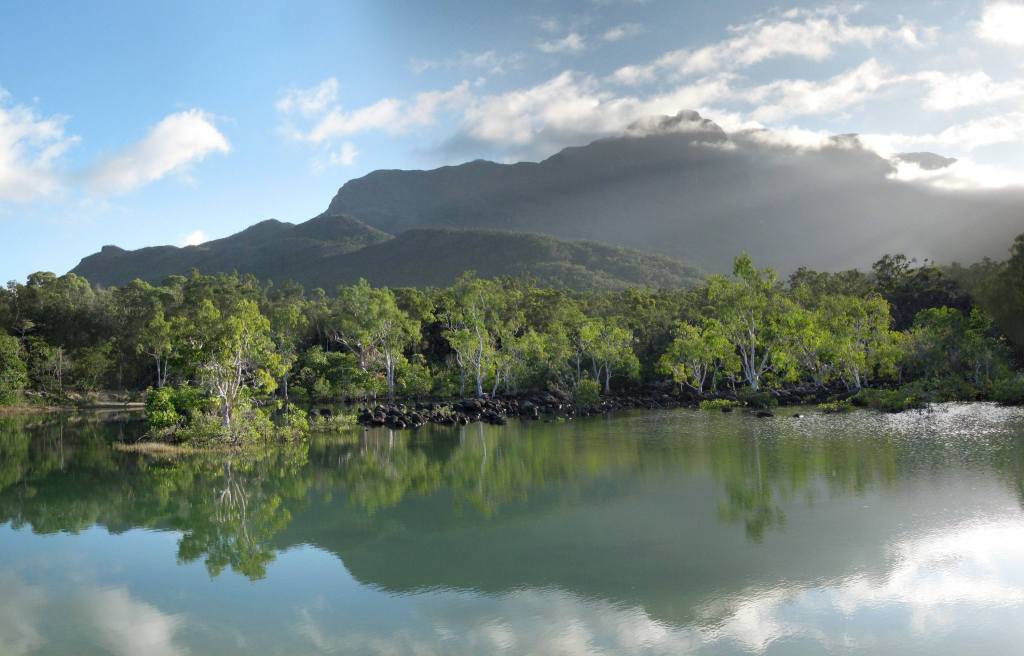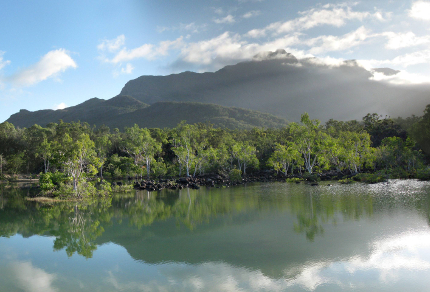With our backpacking excursion of the Thorsborne Trail on North Queensland’s Hinchinbrook Island scheduled to commence next Thursday, we spent today dealing with the nuts and bolts of planning. The island, which lies a few kilometres offshore between Ingham and Cardwell, is within Queensland’s Wet Tropics zone and is Australia’s largest island national park. When viewed from the coastal Bruce Highway, Hinchinbrook exudes a sense of mystery, its forested peaks frequently shrouded in cloud, its mangrove swamps like a barrier to intruders. With no permanent residents and only one wilderness resort (currently closed due to storm damage), the island offers a true Wet Tropics wilderness experience for backpackers who tackle the 32-kilometre Thorsborne Trail on the eastern, exposed side of the island between George Point in the south and Ramsay Bay in the north.
We booked camping permits months ago (only 45 people are allowed on the trail at a time, and it’s world-famous), and have been perusing a Queensland Parks and Wildlife Service information package about the trail. We’ve also downloaded trail section descriptions, which includ information about terrain, vegetation, fresh water sources, and hazards. We’ve learned that native giant white-tailed rats and fawn-footed melomys enjoy feasting on campers’ food and will damage packs and tents to get at it. The solution is to remove all food from packs and store it in metal, rat-proof boxes at the campsites. A friend told Vilis and me that he hadn’t bothered with the boxes and, as a result, rats had chewed into his tent, into his pack to eat his food, and then chewed another hole in his tent on the way out. Hinchinbrook is crocodile country, too, with the big saltwater crocs living in tidal rivers and estuaries. That means we’ll have to pay close attention to crocodile warnings and exercise extreme caution when crossing tidal streams. The danger from marine stingers will be minimal at this time of year, but we’re not planning any ocean swims anyway because of the crocs.
Next, the logistics. We’ve sewed extra straps on our backpacks and repaired our hiking shoes against the expected ravages of rugged terrain and frequent wettings. We’ve booked a ferry to drop us off at George Point on the island’s southern tip on Thursday afternoon, and a different ferry to pick us up at Ramsay Bay at the north end of the trail on Monday morning, plus a bus on Monday afternoon to transport us from the northern ferry port in Cardwell to the southern ferry port in Dungeness, near Lucinda. We’ve chosen camping gear and clothing sparingly, yet recognizing the need to be prepared for wet conditions as well as dry. We’ve composed a list of nourishing, light-weight foods that included dried oatmeal, pasta, rice, couscous, and potato dishes, dried peas and mushrooms, foil-packaged tuna, dried nuts and fruits, peanut M & M’s, and sturdy crackers. A few heavier splurges include fresh apples for each day on the trail, bagels, cheese, salami, jam, honey, and almond butter. We ‘ve added water purification tablets, first aid supplies, sunscreen, and insect repellent, the last to combat the mosquitoes and flies that we hope won’t be as unbearable as we’ve read they might be. Vilis added a paperback novel to his list, and I added binoculars and a list of Hinchinbrook bird species to mine. We’ll carry everything essential to our survival and enjoyment in two backpacks, during five days of immersion in a Wet Tropics wilderness – Hinchinbrook. Let the excitement begin.

Lagoon at Little Ramsay Bay, Hinchinbrook Island (© Vilis Nams)


